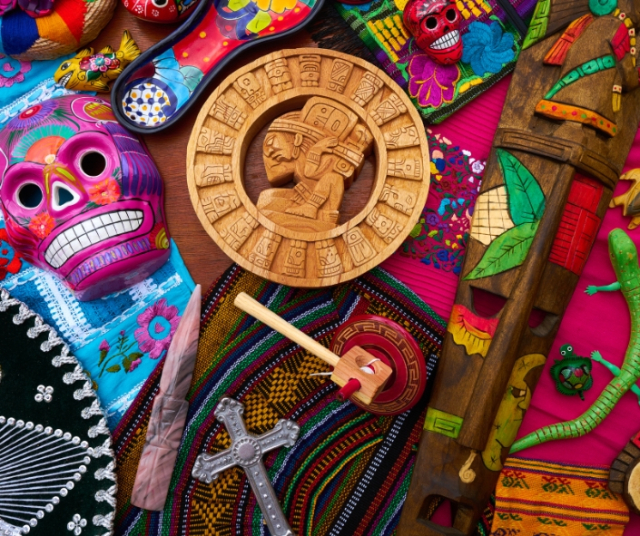Mexico is a country that breathes art and tradition in every corner. Its rich history, cultural diversity and indigenous legacy are spectacularly manifested through Mexican folk art and crafts.
The Soul of Mexico in Its Crafts
Mexican crafts are much more than just objects; They are the materialization of the creative spirit of a people. Each region of Mexico has its own distinctive style of craftsmanship, reflecting the history, geography and cultural identity of that particular area. Here, we will explore some of Mexico's most iconic crafts.
1. Alebrijes: The Dream Made Figure
Alebrijes are fantastic creatures carved from wood and hand painted with vibrant colors. Originally from Oaxaca, these beings mix elements of real and mythological animals. Alebrijes are a true expression of the overflowing imagination of Oaxacan artisans.
2. Huichol: Art in Hilo and Bead
The Huichol, an indigenous community in western Mexico, are known for their thread and bead art. They create intricate geometric designs and animal figures using brightly colored threads and beads. These works of art often depict spiritual and nature themes.
3. Talavera: Elegance in Ceramics
Talavera is a type of glazed ceramic that is produced in Puebla. Its detailed designs and bold colors make it one of the most beautiful ceramics in the world. Talavera artisans have preserved this tradition for centuries.
4. Textiles from Chiapas: Fabrics with History
Chiapas is famous for its traditional textiles. Local weavers use handlooms to create colorful huipils, cuts and rebozos. Each design tells a story and reflects the worldview of the indigenous Chiapas culture.
5. Tarahumara Basketry: Wicker Art
Tarahumara basketry is a testament to the artisanal skill and connection with nature of this indigenous community. They create baskets, traps and other utilitarian objects from wicker and other natural materials.
The Splendor of Mexican Folk Art
Mexican folk art is a window into the nation's history and beliefs. It is often mixed with religion and indigenous traditions to create pieces that are truly unique.
Las Calacas: Catrinas and Catrines
Calacas are elegantly dressed human skeletons and have become an iconic symbol of the Day of the Dead holiday in Mexico. La Catrina, created by artist José Guadalupe Posada, is a particularly famous figure.
Los Matachines: Ritual Dance
The matachines are dance groups that perform ritual performances during religious festivities. These dances often combine indigenous and Catholic elements, creating a unique fusion of traditions.
Papel Picado: Delicacy in Paper
Papel picado is a form of cut paper art used to decorate altars and celebrations. The designs often include religious images, flowers and festive motifs.
Wrestling Masks: Pop Icons
Lucha libre is an important part of Mexican popular culture, and masks are iconic elements in this sport. Each fighter has his distinctive mask that symbolizes his character and honor.
Joy in the Mariachis
Mariachi music is a folkloric musical expression that combines indigenous, Spanish and African elements. The mariachis, with their charro costumes and traditional instruments, represent the joy and passion of Mexico.
The Transcendence of Mexican Art in the World
Mexican art and crafts have transcended the borders of Mexico and have become treasures appreciated around the world. Its beauty, authenticity and deep cultural significance have captivated collectors, art lovers and travelers alike.
Impact on Contemporary Art
Mexican folk art has left a deep mark on the world of contemporary art, and its influence is undeniable in the work of numerous artists both in Mexico and abroad. This impact transcends borders and time, turning traditional expressions into an inexhaustible source of inspiration and creativity in contemporary art.
One of the most prominent examples of this influence is the iconic artist couple of Frida Kahlo and Diego Rivera. Both 20th century Mexican artists incorporated elements of Mexican folklore into their works, creating a unique synthesis of tradition and modernity. Kahlo, in particular, stood out by incorporating typical Mexican costumes into her clothing and capturing folkloric themes and symbols in her self-portrait paintings. His work, full of color and symbolism, is a testimony to the deep roots he felt for his culture and his country.
Beyond Mexico, other contemporary artists have also found inspiration in Mexican crafts and folk art. The combination of vibrant colors, intricate patterns and cultural symbolism has attracted creators from around the world. Sculptors, painters, fashion designers and even architects have incorporated Mexican elements into their works, creating a synergy between the traditional and the contemporary.
The impact of Mexican folk art is not limited only to visual works, but also extends to music and dance. Mariachi, for example, is a Mexican folk musical genre that has influenced musicians and composers around the world. Their vitality and passion have crossed borders, merging with other musical styles and generating new genres.
Craft Markets
In Mexico, craft markets are treasures full of color and culture. At places like the Mercado de la Ciudadela in Mexico City or the Mercado de Artesanías de Oaxaca, visitors can purchase unique pieces and support local artisans.
Festivals and Celebrations
Mexican folk festivals and celebrations, such as Guelaguetza in Oaxaca or Carnival in Veracruz, offer a unique opportunity to experience Mexican art and culture at its finest.
Preserving a Cultural Legacy
The preservation of these traditions is essential to ensure that future generations can appreciate the richness of Mexican art and crafts. Many organizations and artists work tirelessly to promote and keep these forms of cultural expression alive.
